We all know what they look like. We all know how to use them. From the simplest game of Snap to an intense round of poker to a complex game of cribbage, playing cards are the passports to a world of fun and entertainment.
You can play a game like Solitaire all on your lonesome to kill a few hours or you can bring in your friends for a kitchen table gambling session – but no matter what game you are playing it’s those cards that are the key.
How often do you look at your cards, really look at them, and wonder just where they come from? Not the factory but the history. Why those symbols? Why that King? They feel like they have been around forever but they must have started somewhere.
The CasinoPlay.com crew are never ones to take anything at face value, so we shuffled through the available info and cut through the deck to bring you a (short) history of playing cards.
As far as our research can tell, no one actually knows for a fact where and when playing cards became a thing. Bone dice and carved tiles have been around for millennia it seems but the origins of the ever-present and wildly popular decks of cards is shrouded in mystery.
Or is it?
A lot of people look to Europe as the birthplace of playing cards. Some see the Middle East as the forerunners of what we hold in our hands today. But by far the most popular theory is that they developed in China.
While we are not experts at archaeology or anthropology, this last one seems (to us) to be the most logical. China was where paper was first developed. China was where printing first became popular using wooden blocks and ink. China already had quite a history of games of chance involving tiles.
The obvious conclusion to all this is that it was the Chinese who first began woodblock printing images onto paper and using them to play games of chance.
Paper is notoriously susceptible to damage and degradation so finding an intact ancient playing card is far from realistic. We do however have the earliest known reference to playing cards in a 9th century manuscript known as the Collection of Miscellanea at Duyang. This text contains a reference to Princess Tongchan playing the ‘leaf game’ with her family. This ‘leaf game’ was a game that developed in conjunction with the development of writing on sheets of paper during the Tang dynasty.
Other games popular at the time were drinking games that used printed sheets as rules and currency, definitely a precursor to what we now use for our gambling games.
Early Chinese cards usually had coins as symbols but these only came about during the 13th century Ming Dynasty.
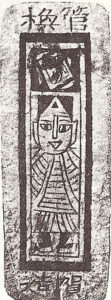
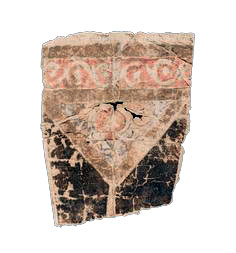
Persia (modern-day Iran) and Arabia were the next stops on the journey of playing cards. Through trade and commerce with the East, the concept of cards and the availability of printed paper meant these handy and fun items began moving across countries and cultures.
References to the Mamluks of the Middle East includes references to card games that featured a vizier, a king, goblets, coins, swords, and polo sticks but, once again, physical evidence is a little lacking.
At last! Some real evidence! Now we can begin putting our cards on the table with our little friends spreading into Egypt and on into Europe.
The Mamluks had a huge influence on Egyptian culture and this included pastimes like card playing. The oldest surviving cards in the world are actually just fragments that date to the 12th and 13th centuries.
With later examples becoming more available, we can see the similarities between these early fragments and a near-complete set of Mamluk playing cards dating to the 15th century. This pack originally contained 52 cards and featured four suits: polo sticks, goblets, coins and swords.
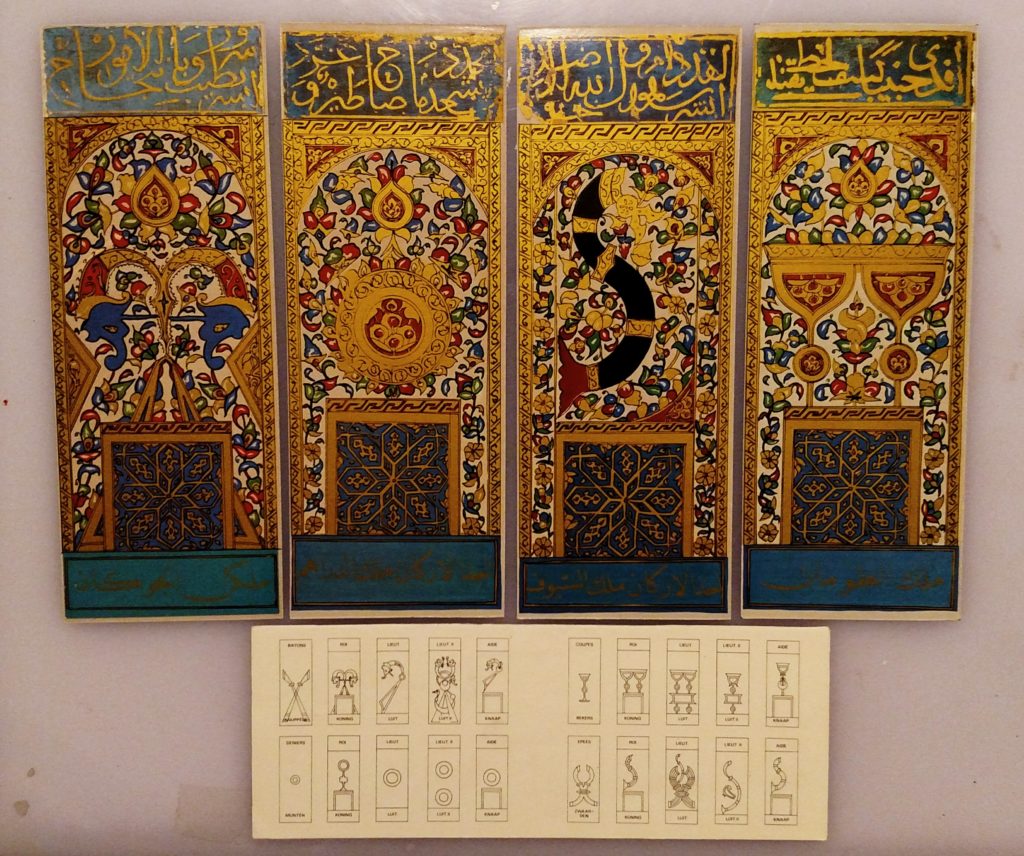
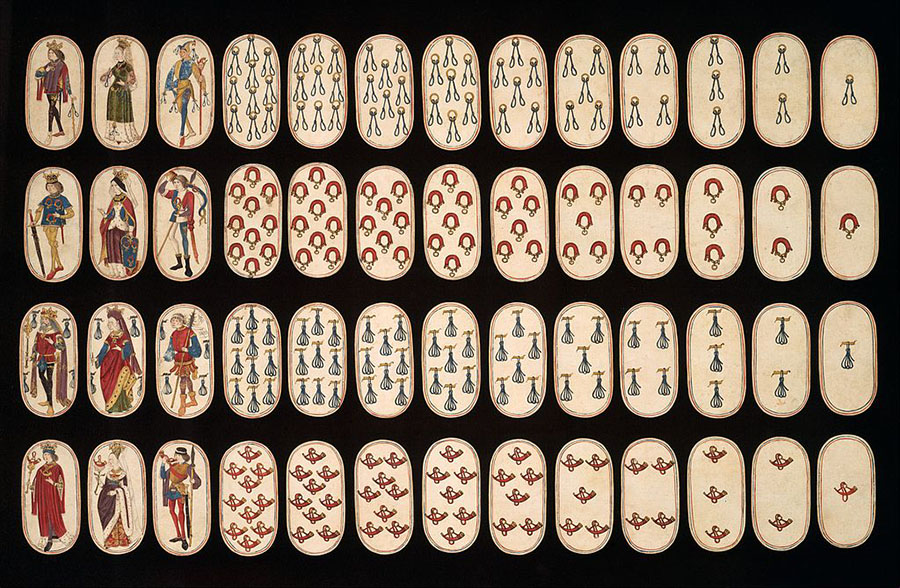
By the time the Mamluk deck was in circulation, playing cards were already popping up in Europe thanks to the wide travels of intrepid traders and explorers. Playing cards were mentioned in several texts from the 13th century – mostly in relation to banning them! In 1367 the city of Berne in present day Switzerland called for the ban on playing cards. In 1377 John of Rheinfelden wrote about the moral implications of playing cards and their related gambling activities.
An accounting book from 1379 (for the Duchess of Brabant and the Duke of Luxembourg) mentions the purchase of a pack of cards for the equivalent of eight and a half sheep! Pretty expensive cards!
The oldest full deck of playing cards still existing comes from the late 1400’s and is known as the Flemish Hunting Deck. You can see this piece of gambling history at the Metropolitan Museum of Art in New York.
Playing cards spread from Italy and Switzerland, through Germany, and into France where they began to take on the look that we know and love today.
And from there across the rest of the world.
Early playing cards looked very different to what we have today. Those early Chinese cards featured coins – single coins, strings of coins and groups of coins – where we see our familiar suits and face cards. The Mamluks used goblets (cups), polo sticks, swords and coins with their face cards being ornate designs rather than faces (most likely due to the religious beliefs of the predominantly Sunni Muslim Mamluks).
Even the European decks looked different – and diverse. Each region seemed to develop its own unique take on the suits and face cards, some of which you can still find today.
And, with a little polishing, you can definitely see the basis for our modern decks.
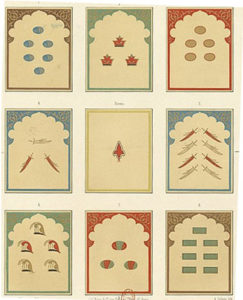
These cards from the Turkey/Arabia region were the first to show what we now view as the suits and are a great clue to why most people believe that playing cards originated in China.
While the Chinese cards featured coins and groupings of coins, the Kanjifa featured coins, polo sticks, cups and swords. The swords and cups in particular seem to be related to the Chinese characters for ‘myriad’ and ‘tens of myriad’ – characters used on their cards.
The earliest suit system in Europe was the Latin suit. This was heavily influenced by the Mamluk decks with the biggest change being the evolving of the polo stick (polo was not a well-known sport in Europe at the time) into the clubs we know today.
The Latin suit was further localised into Northern Italian, Southern Italian, Spanish and Portuguese although the only real difference was the shape of the clubs and swords. Northern Italian had curved swords, Southern Italian and Spanish had straight swords. Northern Italian clubs were baton-like while Southern Italian, Spanish and Portuguese were more like cudgels.
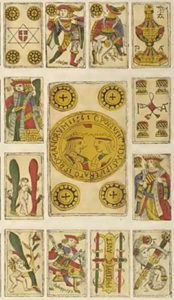
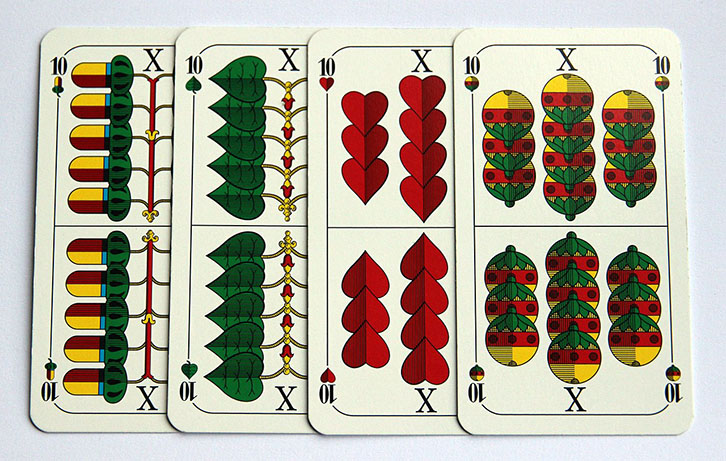
The Germanic suits arose in the 15th century and are the closest to our modern ones. The Swiss-Germans brought shields, acorns, roses and bells into their playing cards around 1450, while the Germans used hearts, leaves, acorns and bells.
Beginning around 1480, the French then used the German suits as the basis for our modern suits: clovers (clubs), tiles (diamonds), hearts and pikes (spades). The simplification of design for the suits probably had a lot to do with making it easier and more cost0ffective to print on the early printing processes of the time.
The French names for the suits were actually trefles, carreaux, couers and piques but these were changed to what we know today as playing cards made their way into England.
Interesting fact: carreaux or diamonds were actually wax-painted tiles found in churches, not the gems we think of today.
During all this innovation and evolution, one thing really stood out: the exclusivity of playing cards.
Card games were the privilege of the wealthy. Printing was hugely expensive and time consuming so only the really well-off could afford to buy playing cards and use them for frivolous entertainments. In fact, a lot of these early decks were hand-painted.
As can be seen above when the Duchess of Brabant and the Duke of Luxembourg bought a set of cards for the equivalent of eight and a half sheep (four peters and two florins – olden days money was weird!) it was a very expensive luxury to be able to say you owned a deck of cards. Even in modern terms, 8 1/2 sheep is quite a lot of wealth.
As printing became more widespread so access to decks of cards became easier. The printing press and the Industrial Revolution soon brought playing cards to the masses and new gambling games and fun games began to develop.
In England, Royal Charters were given to preeminent playing card manufacturers and this led to the standardisation of the suits and the playing cards we use today.
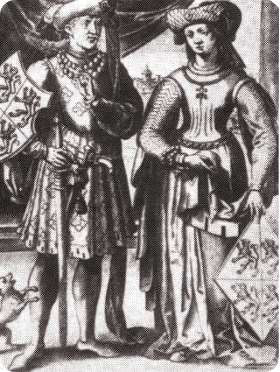

Where would we be without our playing cards? Imagine a casino without card tables. Imagine what you would be doing instead of playing a game of poker with your friends on a Saturday night.
Cards go way beyond just gambling though. Tarot decks are some of the earliest forms of cards. Games like UNO, Trump Card games (remember those? Where you compared statistics and facts to beat your opponent?), early pre-tech Pokémon, they are all just variations and evolutions of the ubiquitous deck of playing cards.
They have found a place in our culture and have become synonymous with fun, chance and even wonder (card tricks and magicians).
Who would have imagined, back in 9th century China, that these small pieces of printed board would have such an enduring influence on our society?
And, just before we leave, one more thing to show how much we love our cards:
We’ve spoken about the suits, but what about the royalty? There are a myriad stories about what the jack, queen and king mean or where they are from, but our favourite is the French tale.
With the gradual dominance of the French suit, their creativity and preference became the norm – and this was especially true of the face cards or what they called the court cards.
Each card was rumoured to represent a famous character from history and the bible with the most loved being:



The CasinoPlay.com crew love our cards and we love finding out more about them. If you have interesting stories or anecdotes about cards, please send them to us! We are always keen on learning more. Like, why is the Ace of Spades the most famous and valuable card? (We do know but we would be interested in seeing what you know).
As always, enjoy your gaming, online or at land-based casinos, but remember to play responsibly. Playing cards have been around for a long, long time and they will still be waiting for you when you decide to take a break and come back to play another day.
| Cookie | Duration | Description |
|---|---|---|
| cookielawinfo-checkbox-analytics | 11 months | This cookie is set by GDPR Cookie Consent plugin. The cookie is used to store the user consent for the cookies in the category "Analytics". |
| cookielawinfo-checkbox-functional | 11 months | The cookie is set by GDPR cookie consent to record the user consent for the cookies in the category "Functional". |
| cookielawinfo-checkbox-necessary | 11 months | This cookie is set by GDPR Cookie Consent plugin. The cookies is used to store the user consent for the cookies in the category "Necessary". |
| cookielawinfo-checkbox-others | 11 months | This cookie is set by GDPR Cookie Consent plugin. The cookie is used to store the user consent for the cookies in the category "Other. |
| cookielawinfo-checkbox-performance | 11 months | This cookie is set by GDPR Cookie Consent plugin. The cookie is used to store the user consent for the cookies in the category "Performance". |
| viewed_cookie_policy | 11 months | The cookie is set by the GDPR Cookie Consent plugin and is used to store whether or not user has consented to the use of cookies. It does not store any personal data. |